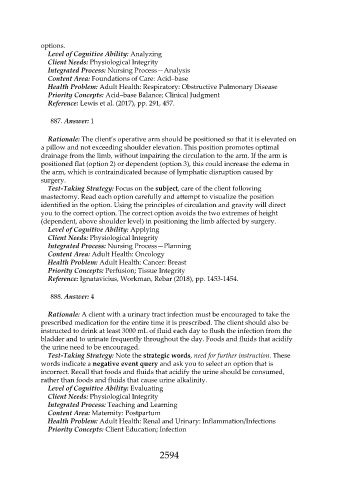Page 2594 - Saunders Comprehensive Review For NCLEX-RN
P. 2594
options.
Level of Cognitive Ability: Analyzing
Client Needs: Physiological Integrity
Integrated Process: Nursing Process—Analysis
Content Area: Foundations of Care: Acid–base
Health Problem: Adult Health: Respiratory: Obstructive Pulmonary Disease
Priority Concepts: Acid–base Balance; Clinical Judgment
Reference: Lewis et al. (2017), pp. 291, 457.
887. Answer: 1
Rationale: The client’s operative arm should be positioned so that it is elevated on
a pillow and not exceeding shoulder elevation. This position promotes optimal
drainage from the limb, without impairing the circulation to the arm. If the arm is
positioned flat (option 2) or dependent (option 3), this could increase the edema in
the arm, which is contraindicated because of lymphatic disruption caused by
surgery.
Test-Taking Strategy: Focus on the subject, care of the client following
mastectomy. Read each option carefully and attempt to visualize the position
identified in the option. Using the principles of circulation and gravity will direct
you to the correct option. The correct option avoids the two extremes of height
(dependent, above shoulder level) in positioning the limb affected by surgery.
Level of Cognitive Ability: Applying
Client Needs: Physiological Integrity
Integrated Process: Nursing Process—Planning
Content Area: Adult Health: Oncology
Health Problem: Adult Health: Cancer: Breast
Priority Concepts: Perfusion; Tissue Integrity
Reference: Ignatavicius, Workman, Rebar (2018), pp. 1453-1454.
888. Answer: 4
Rationale: A client with a urinary tract infection must be encouraged to take the
prescribed medication for the entire time it is prescribed. The client should also be
instructed to drink at least 3000 mL of fluid each day to flush the infection from the
bladder and to urinate frequently throughout the day. Foods and fluids that acidify
the urine need to be encouraged.
Test-Taking Strategy: Note the strategic words, need for further instruction. These
words indicate a negative event query and ask you to select an option that is
incorrect. Recall that foods and fluids that acidify the urine should be consumed,
rather than foods and fluids that cause urine alkalinity.
Level of Cognitive Ability: Evaluating
Client Needs: Physiological Integrity
Integrated Process: Teaching and Learning
Content Area: Maternity: Postpartum
Health Problem: Adult Health: Renal and Urinary: Inflammation/Infections
Priority Concepts: Client Education; Infection
2594

